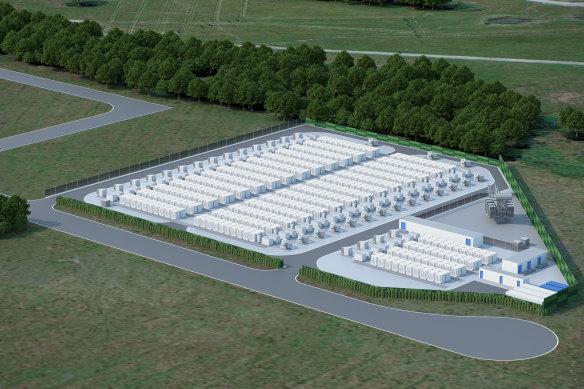By Nick Toscano
British energy major Shell has selected a suburb in south-eastern Melbourne as the location for its first direct investment in a big battery project anywhere in the world.
Shell, one of Australia’s largest liquefied natural gas (LNG) producers, is using its global scale in oil and gas to push into deeper into cleaner energy, and on Friday said it had struck a deal with Macquarie Asset Management to develop a two-hour big battery at the Rangebank business park in Cranbourne.

Oil giant Shell has given the green light to a big battery project in Cranbourne, its first investment in a grid-scale battery anywhere in the world.
Once fully operational, the 200-megawatt, 400-megawatt-hour battery system will have the storage capacity to power the equivalent of 80,000 homes across Victoria for an hour during periods of peak demand.
Shell and Macquarie’s Green Investment Group on Friday said the battery would boost Victoria’s ability to host more renewable energy by increasing the state’s “firming capacity” – flexible energy supply that can be called on to top up the grid when needed – and providing crucial services to support the stability of the system. The project, which industry sources said would cost between $300 million and $400 million, has already reached financial close, and is expected to be completed by 2024.
“The Rangebank project is our first grid-scale battery investment in Victoria and marks Shell’s first direct equity investment in a utility-scale battery energy storage system globally,” Shell Energy Australia chief executive Greg Joiner said.
The company is now expecting to build a similar-sized big battery each year in Australia in coming years as the clean energy transition accelerated.
“Provided you’ve got the right investment parameters for making these sorts of investments, then we’d expect something in the order of a project of this sort of size once a year as the market is unfolding, complementing the build-out of renewables,” Joiner said.
As Australia’s shift away from coal-fired power gathers speed, authorities say big batteries must play an increasingly important role because of their ability to store renewable energy when it’s most abundant and dispatch it at times when it’s not sunny or windy.
The typical size of today’s batteries means they will often quickly exhaust their storage energy in one to four hours of maximum output. However, batteries can ramp up immediately and inject bursts of power to fill urgent gaps in supply or stabilise the frequency of the network.
The Albanese government has set a target for the grid to be 82 per cent powered by clean energy by 2030. The Australian Energy Market Operator (AEMO) expects 60 per cent of the eastern seaboard’s coal fleet could exit the grid by that time, requiring a massive increase in spending on projects such as batteries, fast-start gas plants and pumped hydro to provide back-up for renewable energy.
While coal-fired electricity still accounts for most of the nation’s power supply, the influx of cheaper-to-run renewable energy has been radically reshaping the market and undercutting coal’s economic viability, leading to power suppliers AGL, Origin Energy and EnergyAustralia bringing forward the closure dates of some of Australia’s largest generators.
Greg Callman, the head of energy technology at Macquarie’s Green Investment Group, said demand for storage solutions was “growing rapidly”.
Shell is also involved in the development of other big batteries in Australia, including the Riverina, Wellington and Wallerawang batteries in NSW, either by signing on as a customer or contributing capital. However, the Rangebank project marks the company’s first equity investment in a big battery project globally.
Shell said it had chosen the site in Cranbourne because of the area’s strong connectivity to the electrical grid.
The Rangebank system will be built, serviced, and maintained by Fluence, a global provider of energy storage products and services.
The Business Briefing newsletter delivers major stories, exclusive coverage and expert opinion. Sign up to get it every weekday morning.